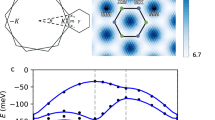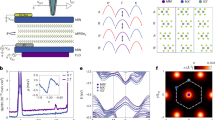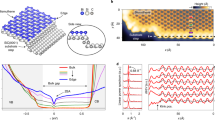Abstract
Near the boundary between ordered and disordered quantum phases, several experiments have demonstrated metallic behaviour that defies the Landau Fermi paradigm1,2,3,4,5. In moiré heterostructures, gate-tuneable insulating phases driven by electronic correlations have been recently discovered6,7,8,9,10,11,12,13,14,15,16,17,18,19,20,21,22,23. Here, we use transport measurements to characterize metal–insulator transitions (MITs) in twisted WSe2 near half filling of the first moiré subband. We find that the MIT as a function of both density and displacement field is continuous. At the metal–insulator boundary, the resistivity displays strange metal behaviour at low temperatures, with dissipation comparable to that at the Planckian limit. Further into the metallic phase, Fermi liquid behaviour is recovered at low temperature, and this evolves into a quantum critical fan at intermediate temperatures, before eventually reaching an anomalous saturated regime near room temperature. An analysis of the residual resistivity indicates the presence of strong quantum fluctuations in the insulating phase. These results establish twisted WSe2 as a new platform to study doping and bandwidth-controlled metal–insulator quantum phase transitions on the triangular lattice.
This is a preview of subscription content, access via your institution
Access options
Access Nature and 54 other Nature Portfolio journals
Get Nature+, our best-value online-access subscription
$29.99 / 30 days
cancel any time
Subscribe to this journal
Receive 51 print issues and online access
$199.00 per year
only $3.90 per issue
Buy this article
- Purchase on Springer Link
- Instant access to full article PDF
Prices may be subject to local taxes which are calculated during checkout





Similar content being viewed by others
Data availability
The data that support the findings of this study are available from the corresponding authors upon request.
References
Varma, C. M. Colloquium: linear in temperature resistivity and associated mysteries including high temperature superconductivity. Rev. Mod. Phys. 92, 031001 (2020).
Paschen, S. & Si, Q. Quantum phases driven by strong correlations. Nat. Rev. Phys. 3, 9–26 (2020).
Zaanen, J. Why the temperature is high. Nature 430, 512-513 (2004).
Imada, M., Fujimori, A. & Tokura, Y. Metal-insulator transitions. Rev. Mod. Phys. 70, 1039–1263 (1998).
Taillefer, L. Scattering and pairing in cuprate superconductors. Annu. Rev. Condens. Matter Phys. 1, 51–70 (2010).
Cao, Y. et al. Correlated insulator behaviour at half-filling in magic-angle graphene superlattices. Nature 556, 80–84 (2018).
Cao, Y. et al. Unconventional superconductivity in magic-angle graphene superlattices. Nature 556, 43–50 (2018).
Yankowitz, M. et al. Tuning superconductivity in twisted bilayer graphene. Science 363, 1059–1064 (2019).
Burg, G. W. et al. Correlated insulating states in twisted double bilayer graphene. Phys. Rev. Lett. 123, 197702 (2019).
Liu, X. Tunable spin-polarized correlated states in twisted double bilayer graphene. Nature 583, 221–225 (2020).
Shen, C. et al. Correlated states in twisted double bilayer graphene. Nat. Phys. 16, 520–525 (2020).
Cao, Y. Tunable correlated states and spin-polarized phases in twisted bilayer–bilayer graphene. Nature 583, 215-220 (2020).
Wang L., et al Correlated electronic phases in twisted bilayer transition metal dichalcogenides. Nat. Mater. 19, 861–866 (2020).
Regan, E. C. et al. Mott and generalized Wigner crystal states in WSe2/WS2 moiré superlattices. Nature 579, 359–363 (2020).
Tang, Y. et al. Simulation of Hubbard model physics in WSe2/WS2 moiré superlattices. Nature 579, 353 (2020).
Chen, S. et al. Electrically tunable correlated and topological states in twisted monolayer–bilayer graphene. Nat. Phys. 17, 374–380 (2021).
Xu, S. et al. Tunable van Hove singularities and correlated states in twisted monolayer–bilayer graphene. Nat. Phys. 17, 619–626 (2021).
Chen, G. et al. Evidence of a gate-tunable Mott insulator in a trilayer graphene moiré superlattice. Nat. Phys. 15, 237 (2019).
Hao, Z. et al. Electric field–tunable superconductivity in alternating-twist magic-angle trilayer graphene. Science 371, 1133–1138 (2021).
Park, J. M. et al. Tunable strongly coupled superconductivity in magic-angle twisted trilayer graphene. Nature 590, 249–255 (2021).
Kerelsky, A. et al. Maximized electron interactions at the magic angle in twisted bilayer graphene, Nature 572, 95–100 (2019).
Cao, Y. et al. Nematicity and competing orders in superconducting magic-angle graphene. Science 372, 264–271 (2020)
Rubio-Verdú, C. et al. Universal moiré nematic phase in twisted graphitic systems. Preprint at http://arxiv.org/abs/2009.11645 (2020).
Pan, H., Wu, F. & Das Sarma, S. Band topology, Hubbard model, Heisenberg model, and Dzyaloshinskii-Moriya interaction in twisted bilayer WSe2. Phys. Rev. Res. 2, 033087 (2020).
Zhang, Z. et al. Flat bands in twisted bilayer transition metal dichalcogenides. Nat. Phys. 16, 1093–1096 (2020).
Cao, Y. et al. Strange metal in magic-angle graphene with near Planckian dissipation Phys. Rev. Lett. 124, 076801 (2020).
Kormányos, A. et al. k.p theory for two-dimensional transition metal dichalcogenide semiconductors. 2D Mater. 2, 022001 (2015).
Bruin, J. A. N., Sakai, H., Perry, R. S. & Mackenzie, A. P. Similarity of scattering rates in metals showing T-linear resistivity. Science 339, 804–807 (2013).
Giraldo-Gallo, P. et al. Scale-invariant magnetoresistance in a cuprate superconductor. Science 361, 479–481 (2018).
Hayes, I. M. et al. Scaling between magnetic field and temperature in the high-temperature superconductor BaFe2(As1−x Px)2. Nat. Phys. 12, 916–919 (2016).
Movva, H. C. P. et al. Density-dependent quantum Hall states and Zeeman splitting in monolayer and bilayer WSe2. Phys. Rev. Lett. 118, 247701 (2017).
Motrunich, O. I. Variational study of triangular lattice spin-1/2 model with ring exchanges and spin liquid state in κ−(ET)2Cu2(CN)3. Phys. Rev. B 72, 045105 (2005).
Sahebsara, P. & Sénéchal, D. Hubbard model on the triangular lattice: spiral order and spin liquid. Phys. Rev. Lett. 100, 136402 (2008).
Szasz, A., Motruk, J., Zaletel, M. P. & Moore, J. E. Chiral spin liquid phase of the triangular lattice Hubbard model: a density matrix renormalization group study. Phys. Rev. X 10, 021042 (2020).
Polshyn, H. et al. Large linear-in-temperature resistivity in twisted bilayer graphene. Nat. Phys. 15, 1011–1016 (2019).
Wu, F., Hwang, E. & Das Sarma, S. Phonon-induced giant linear-in-T resistivity in magic angle twisted bilayer graphene: ordinary strangeness and exotic superconductivity. Phys. Rev. B 99, 165112 (2019).
Sharma, G. et al. Carrier transport theory for twisted bilayer graphene in the metallic regime. Preprint at: http://arxiv.org/abs/2003.00018 (2020).
Senthil, T. Theory of a continuous Mott transition in two dimensions. Phys. Rev. B 78, 045109 (2008).
Pan, H. & Das Sarma, S. Interaction-driven filling-induced metal-insulator transitions in 2D moiré lattices. Phys. Rev. Lett. 127, 096802 (2021).
Wang, L. et al. One-dimensional electrical contact to a two-dimensional material. Science 342, 614–617 (2013).
Kim, K. van der Waals heterostructures with high accuracy rotational alignment. Nano Lett. 16, 1989–1995 (2016).
Movva, H. C. P. et al. High-mobility holes in dual-gated WSe2 field-effect transistors. ACS Nano 9, 10402–10410 (2015).
Acknowledgements
We thank J. Cano, A. Georges, C. Varma, T. Uemura, T. Senthil, I. Bozovic, M. Yankowitz, S. Das Sarma, Q. Si, A. Tsvelik, A. Wietek and J. Wang for fruitful discussions. Studies of the quantum critical behaviour of twisted bilayer WSe2 were supported as part of Programmable Quantum Materials, an Energy Frontier Research Center funded by the US Department of Energy, Office of Science, Basic Energy Sciences, under award DE-SC0019443. The synthesis of the WSe2 crystals was supported by the National Science Foundation Materials Research Science and Engineering Centers programme through Columbia University in the Center for Precision-Assembled Quantum Materials (DMR-2011738). Support for cryogenic measurements was provided by the Air Force Office of Scientific Research through grant FA9550- 16-1-0601. The Flatiron Institute is a division of the Simons Foundation.
Author information
Authors and Affiliations
Contributions
A.G., L.W., E.-M.S. and D.A.R. fabricated the samples. A.G., L.W. and E.-M.S. performed the transport measurements. A.G. and G.S.S.G.P. analysed the data. D.A.R., B.K. and J.H. grew the WSe2 crystals. K.W. and T.T. grew the hBN crystals. J.Z. and A.J.M. supervised the theoretical aspects of this work. A.G., A.N.P., C.R.D. and A.J.M wrote the manuscript with input from all the authors.
Corresponding authors
Ethics declarations
Competing interests
The authors declare no competing interests.
Additional information
Peer review information Nature thanks You Zhou and the other, anonymous, reviewer(s) for their contribution to the peer review of this work.
Publisher’s note Springer Nature remains neutral with regard to jurisdictional claims in published maps and institutional affiliations.
Extended data figures and tables
Extended Data Fig. 1 Quantum critical transport at a twist angle of 4.5 °.
a, color plot of resistivity as a function of temperature and doping. b, line cuts showing the regimes of T2, T-linear and insulating behaviour as a function of doping.
Extended Data Fig. 2 Arrhenius fits to resistance.
When our samples show insulating behaviour, they display metal-insulator transition region that is 1-5 K wide. Below the metal-insulator transition, the temperature-dependent resistance displays activated behaviour over 1-2 decades in resistance. Arrhenius fits to extract gap magnitudes are made in this range of temperature. At the lowest temperature, the temperature dependence is often not exponential, likely due to disorder. Shown here is an example of a typical curve that has the insulating temperature dependence described above. The linear fit is defined over a region chosen such that r2 is maximized (always greater than 0.9).
Extended Data Fig. 3 Planckian parameter C.
Planckian parameter C defined from fits to T-linear resistivity on a device with twist angle 4.2 ◦ and top gate voltage TG = −6.75V and plotted against nominal density ν as defined in the text. The insulating regime extends from ν ≈ −1.15 to ν ≈ −0.95.
Extended Data Fig. 4 Anomalous magnetotransport for 4.2˚ twist sample.
a, Longitudinal and c, Hall magnetoresistance as a function of doping density in the metallic regime, approaching the quantum critical point. b, Temperature dependence for the same doping range. d, Fit coefficient β from ρ(B) ∝ \(\sqrt{\gamma +\beta {B}^{2}}\)shows a marked increase on approaching the quantum critical point near ν = −1.
Extended Data Fig. 5 Magnetotransport beyond full filling.
B-quadratic behaviour of a, longitudinal resistivity near full-filling. b, The Hall effect shows a sign change as is expected when going across bands.
Extended Data Fig. 6 Collapse of the Fermi temperature in the D-driven transition.
Quadratic coefficient versus displacement field at half-filling for the 4.2˚ sample. The rise of αQ as one approaches the displacement field-driven metal-insulator transition indicates the collapse of the Fermi temperature similarly to what is observed in the doping-driven transition.
Extended Data Fig. 7 Hartree-Fock calculations at half-filling.
Our Hartree-Fock calculations are based on an effective single-band Hubbard model with on-site interactions with a bandwidth chosen to match DFT calculations of the electronic structure. At zero displacement field, the system goes from paramagnetic metal to 120◦antiferromagnetic metal with a first order transition at non-zero Uc1, then quickly becomes an insulator at a slightly larger Uc2. As the displacement field is applied, the critical Uc1 to turn on magnetism decreases first and then increases continuously. The Uc2 of the metal-insulator transition and the size of the energy gap change in the same manner. Shown here are the energy gap sizes versus displacement field at a twist angle of 5.09˚.
Extended Data Fig. 8 Non-magnetism in the insulating gap.
Correlated gap versus B field for different displacement fields for the 4.2˚ sample. The correlated gap is non-magnetic and eventually closes at higher magnetic fields. When a perpendicular magnetic field is applied, we would expect the insulating gap to increase if the insulator is a ferromagnet, while we would expect it to decrease if it is an antiferromagnetic state or a spin liquid.
Extended Data Fig. 9 Ohmic contacts and twist angle homogeneity.
a, Optical microscope image of the 4.2˚ sample. b, Representative I-V at 200mK for the 4.2˚ sample indicating good contact quality. Curves are offset for clarity. Dashed lines indicate Vxx = 0. We find our contact resistances to be between 2 to 10kΩ for all contacts for the data shown in main figures and that value is fairly temperature independent. We perform a four-probe measurement to minimize the effects of contact resistance. We also monitor the lock-in phase of our low frequency (∼17.7Hz) AC measurements to ensure that it is close to zero at all times. c, Resistivity curves at 1.6K from two different pairs of leads, they correspond to slightly different twist angles for the two pairs of contacts (4.1˚ and 4.2˚). Crossed out leads indicated high contact resistance. Hall bar channel is 3µm wide and 7µm long.
Extended Data Fig. 10 Crossover from T-quadratic to T-linear at ν = −0.84 for 4.2˚ sample.
An example of our fitting procedures described in our method section is shown here for the doping of ν = −0.84 (also in the main text figure 3c). We find that the resistivity is fit well (r2 = 0.997) by a T2 form up to a temperature of 16.5K, and is fit well (r2 = 0.993) by T− linear form between 16.5 and 47 K. We note that a linear fit between 1.6 and 6 K yields a r2 of 0.92, clearly worse than the quadratic fit.
Supplementary information
Rights and permissions
About this article
Cite this article
Ghiotto, A., Shih, EM., Pereira, G.S.S.G. et al. Quantum criticality in twisted transition metal dichalcogenides. Nature 597, 345–349 (2021). https://doi.org/10.1038/s41586-021-03815-6
Received:
Accepted:
Published:
Issue Date:
DOI: https://doi.org/10.1038/s41586-021-03815-6
This article is cited by
-
Electric field tunable bandgap in twisted double trilayer graphene
npj 2D Materials and Applications (2024)
-
Ultraviolet interlayer excitons in bilayer WSe2
Nature Nanotechnology (2024)
-
Realization of the Haldane Chern insulator in a moiré lattice
Nature Physics (2024)
-
Unconventional superconducting quantum criticality in monolayer WTe2
Nature Physics (2024)
-
Excitonic Mott insulator in a Bose-Fermi-Hubbard system of moiré WS2/WSe2 heterobilayer
Nature Communications (2024)
Comments
By submitting a comment you agree to abide by our Terms and Community Guidelines. If you find something abusive or that does not comply with our terms or guidelines please flag it as inappropriate.



